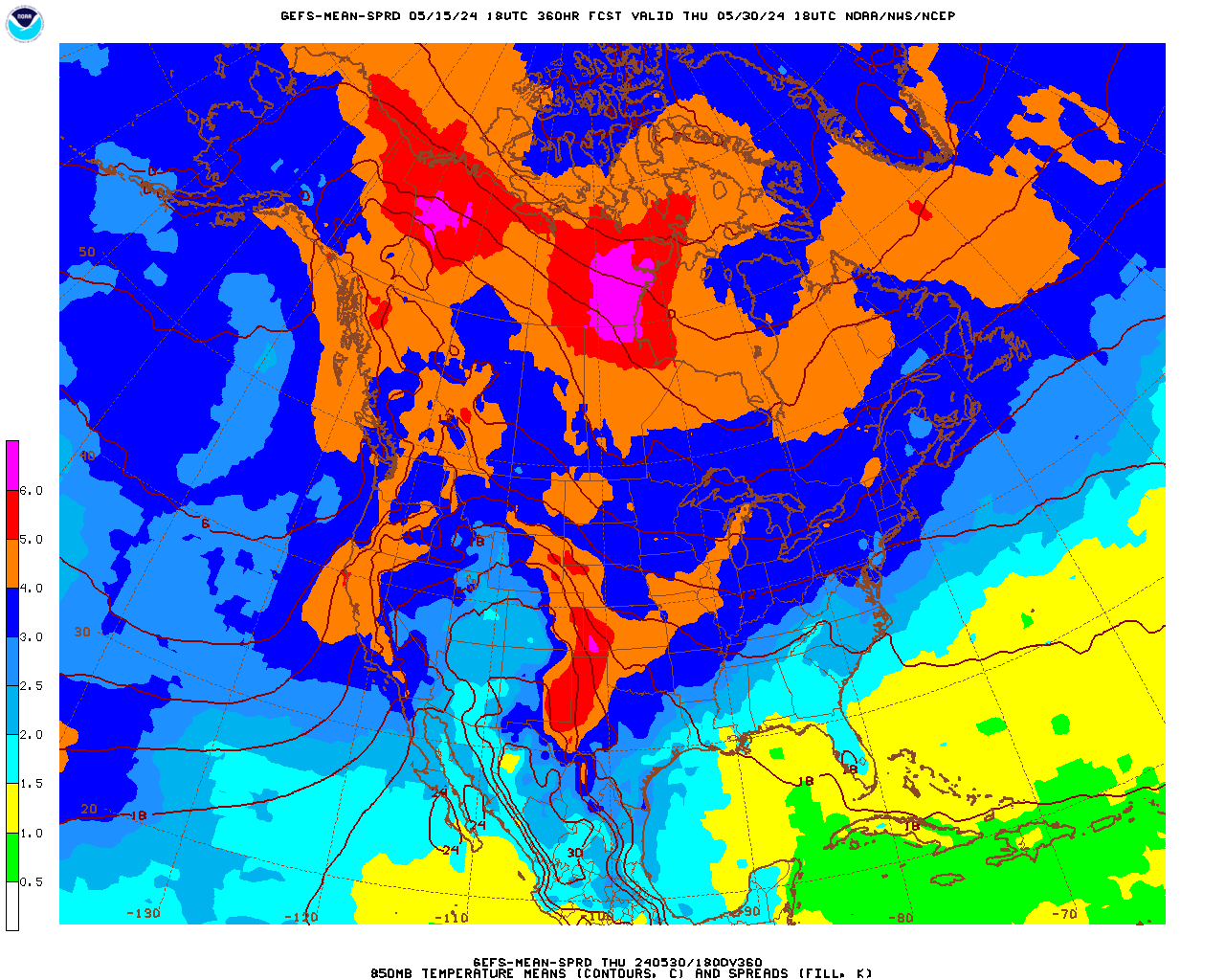
Happy February 16th! Keep sharing your Valentines love with somebody today. There's enough for every day of the year!
Scroll down and enjoy the latest comprehensive weather to the max. Excessive rain event setting up in the middle of next week. Scroll down to see where.
Here are the latest hazards across the country.
Purple/Pink/blue on land is cold/Winter weather. Brown is wind, Green is flooding. Gray is fog. Reddish is a red flag advisory.
Go to the link below, then hit the location/county on the map for details.
https://www.spc.noaa.gov/ Go to "hazards"





Current Jet Stream

Winter Weather
https://www.wpc.ncep.noaa.gov/wwd/winter_wx.shtml
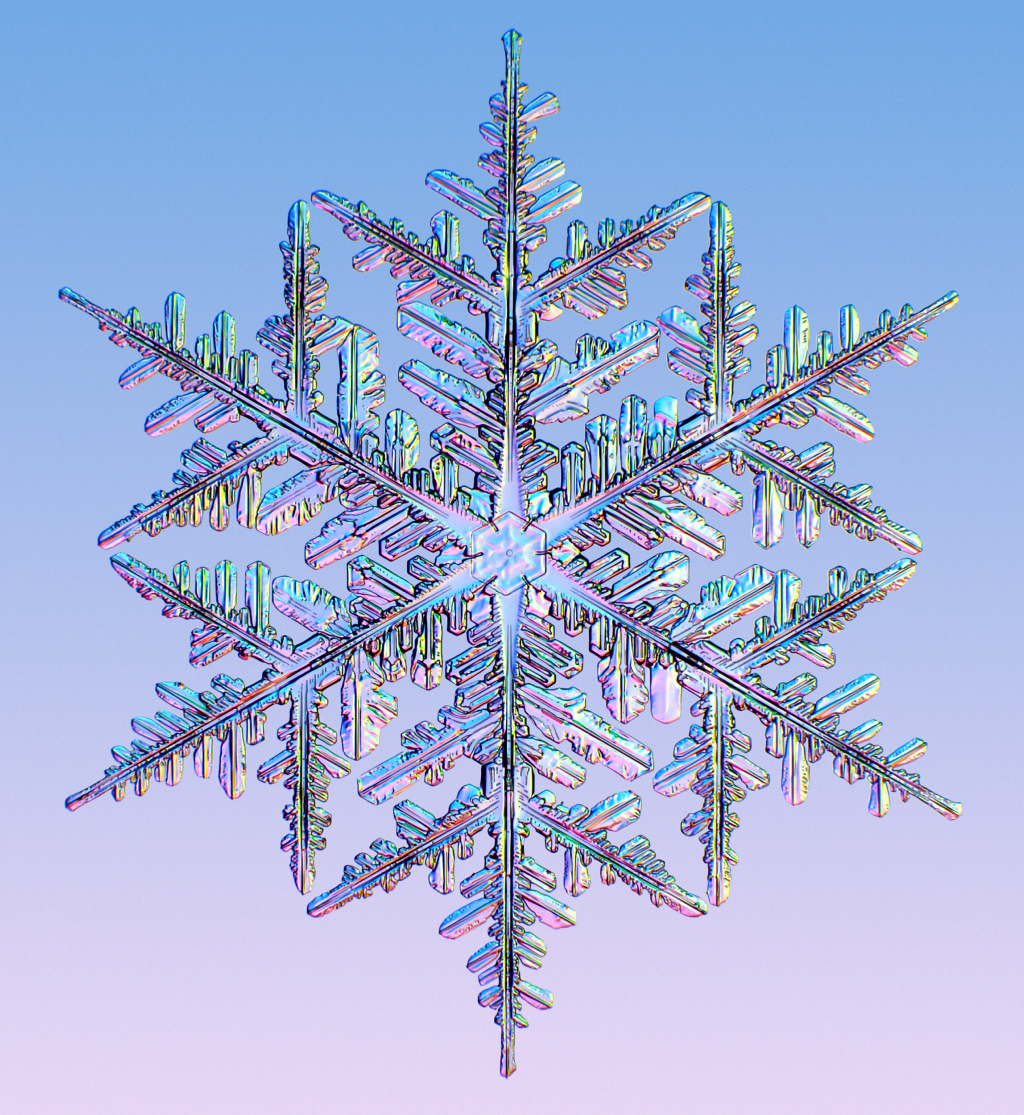
Snowfall the next 3 days:
Forecast Hour: 084
Image URL: http://mag.ncep.noaa.gov/data/nam/12/nam_namer_084_snodpth_chng.gif
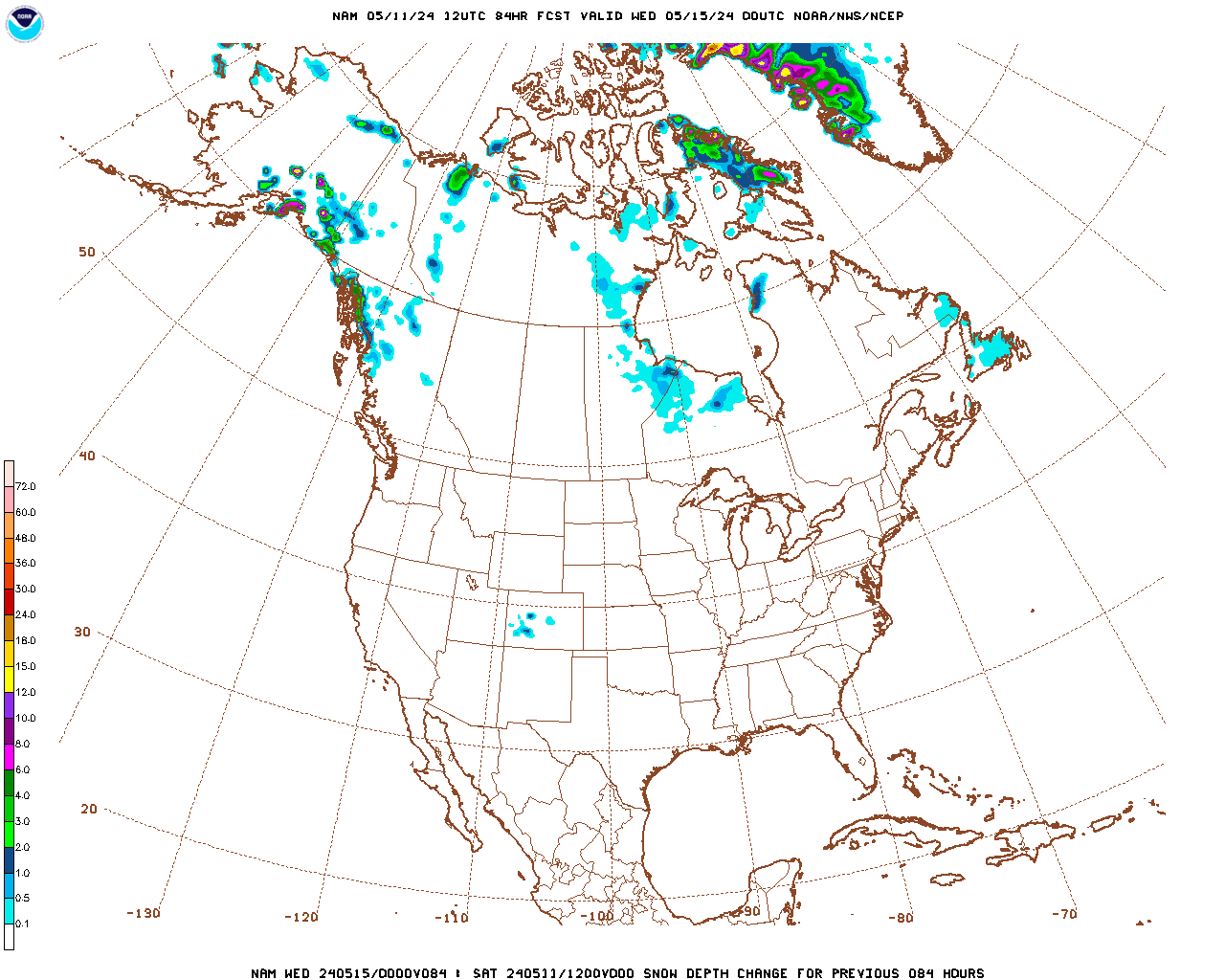
| Low Temperatures Tomorrow Morning |

High Temperatures
Huge Temperature contrast from N.Plains to the far south.



Highs for days 3-7:
Very Cold NorthCentral to N. Rockies. Mild far South/Southeast. Rainbow of colors.
Bigger warm up today during this period vs yesterday.
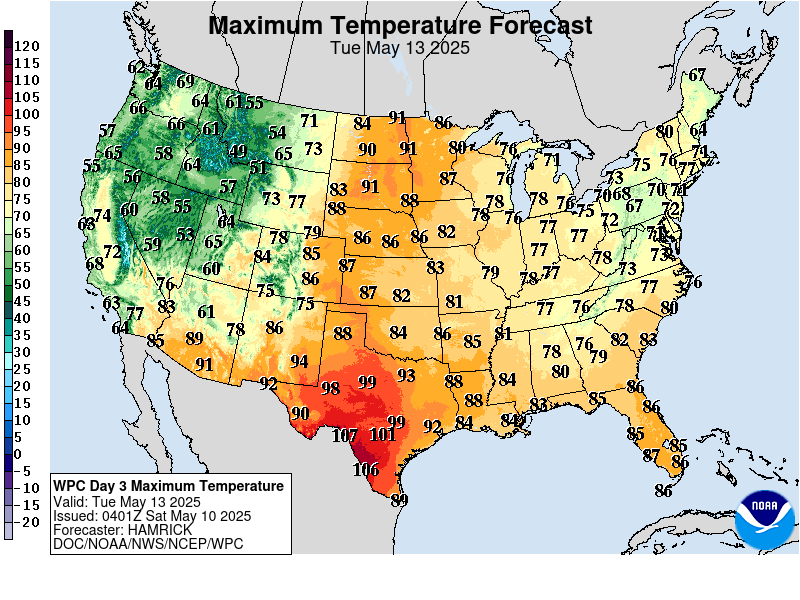
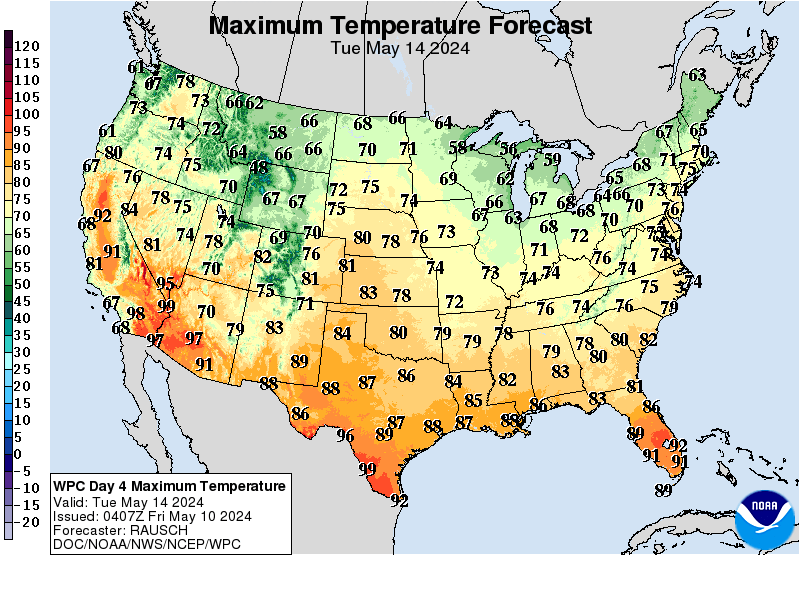
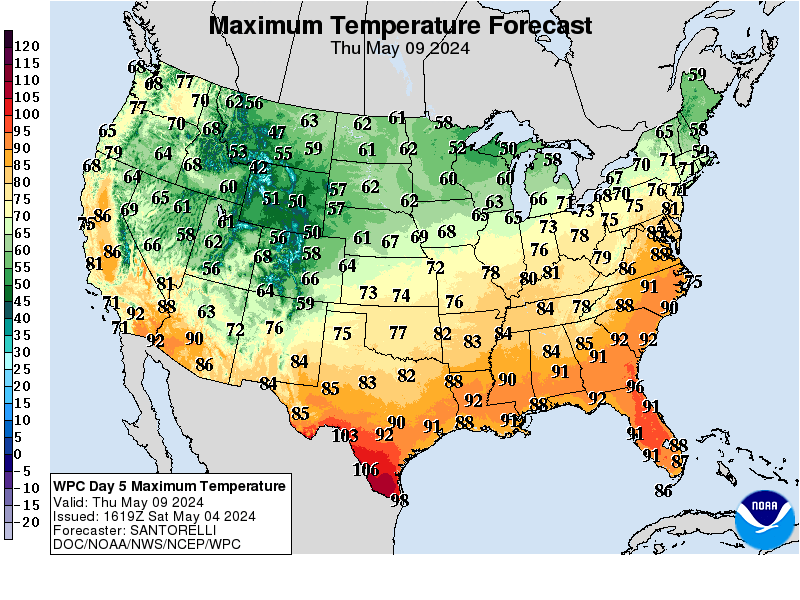
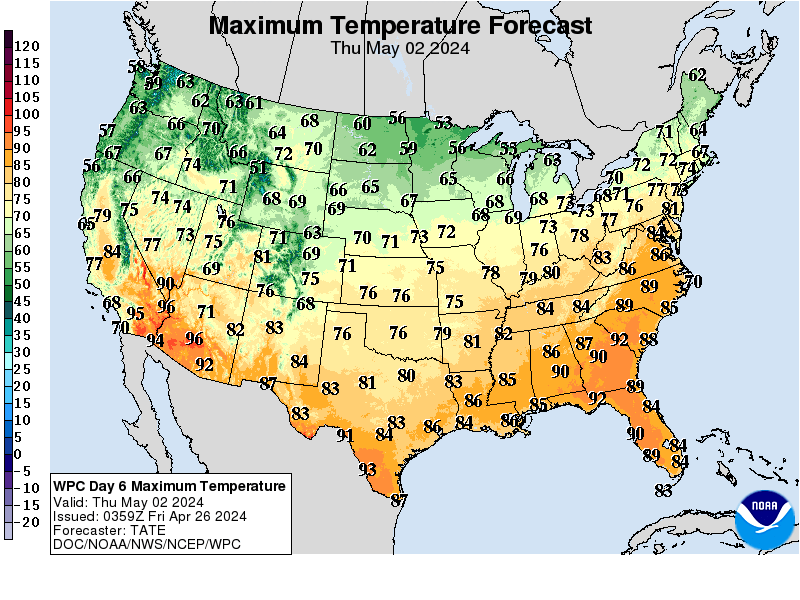
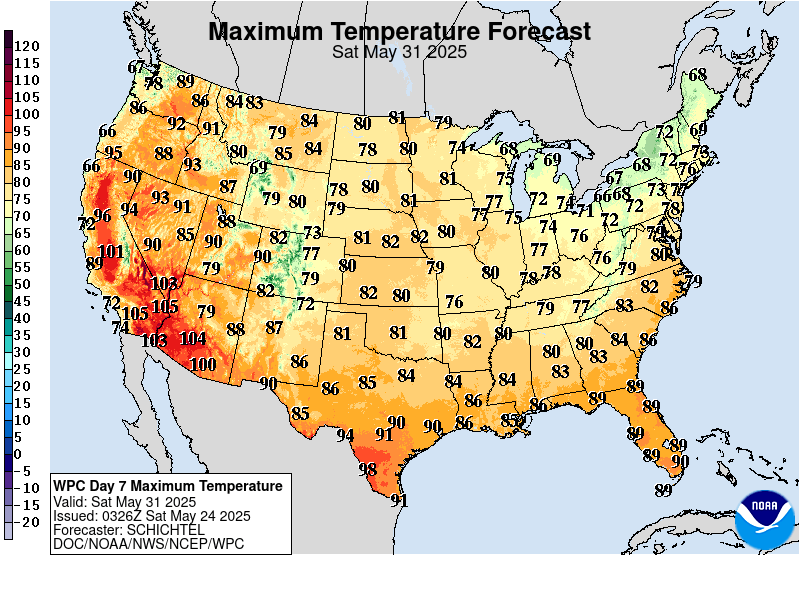
How do these days 3-7 temperatures compare to average at this time of year?
Incredible temperature contrast across the country from frigid Plains/Rockies to warm FAR southeast. Cold moderates this period.
https://www.wpc.ncep.noaa.gov/medr/medr_mean.shtml
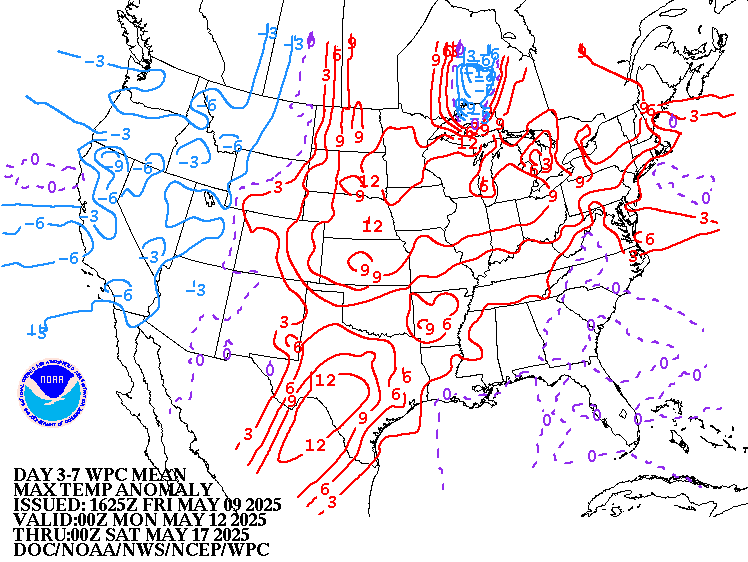
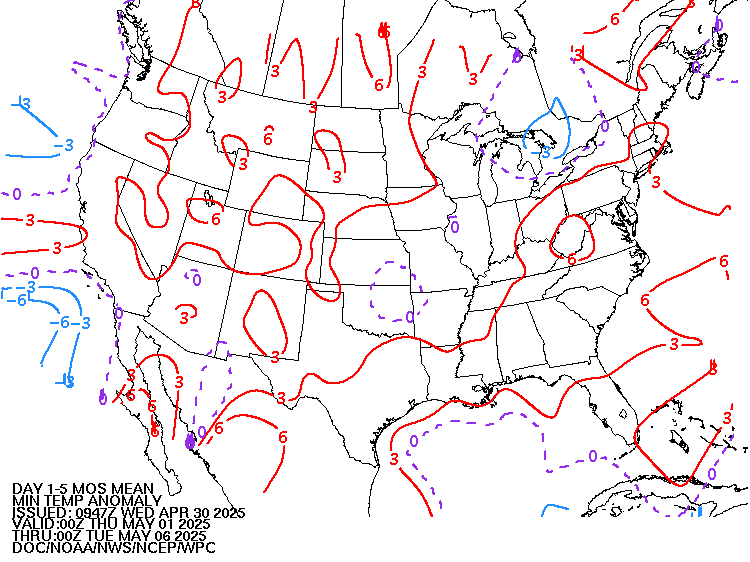
Weather maps for days 3-7 below:
Southern stream battles Northern stream. Cold air from northern stream erodes next week.
Southern stream systems in the S/SE. A major one will produce excessive rains early next week.
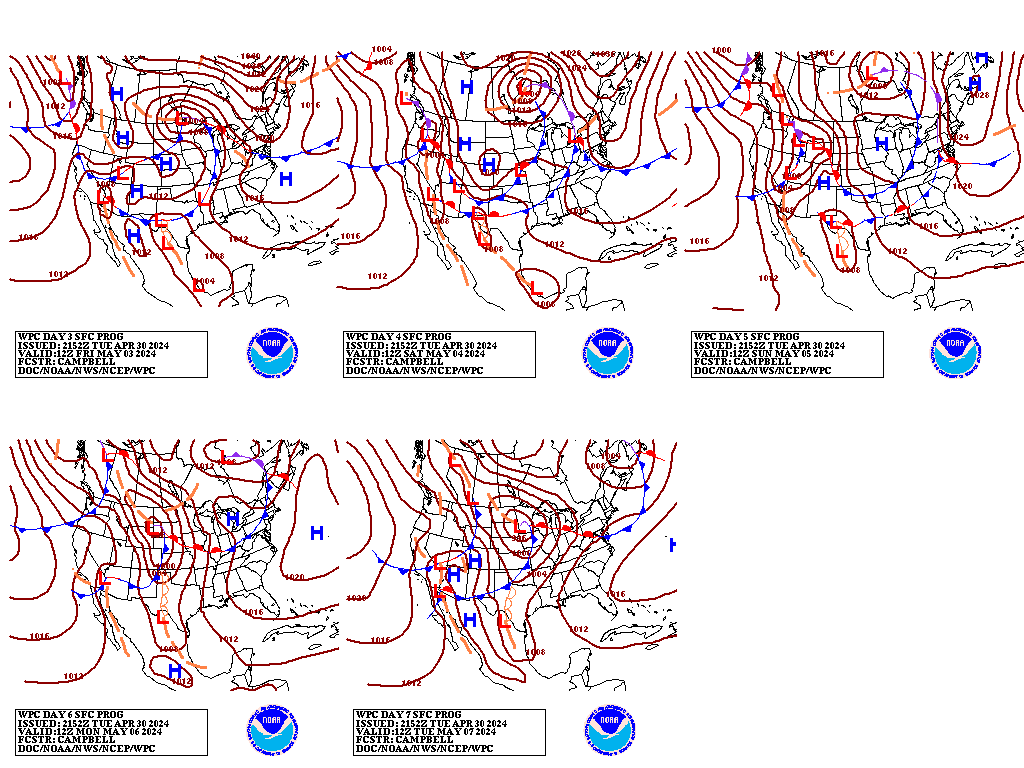
Liquid equivalent precip forecasts for the next 7 days are below.
Excessive rain event Tennessee Valley and just southeast next week.
Day 1 below:
http://www.wpc.ncep.noaa.gov/qpf/fill_94qwbg.gif?1526306199054
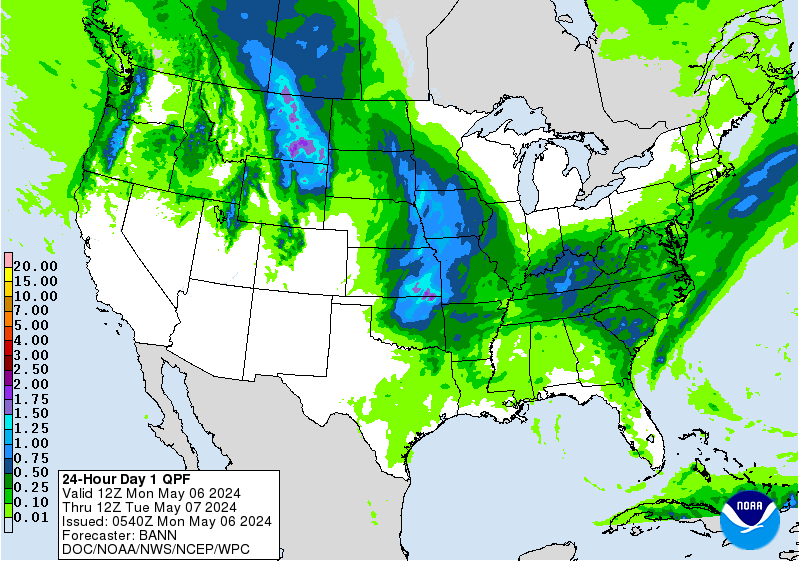
Day 2 below:
http://www.wpc.ncep.noaa.gov/qpf/fill_98qwbg.gif?1528293750112
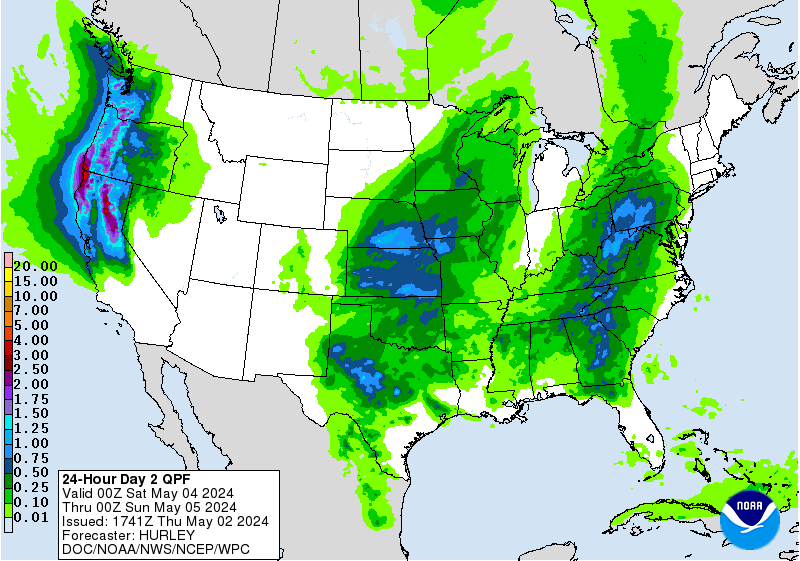
Day 3 below
http://www.wpc.ncep.noaa.gov/qpf/fill_99qwbg.gif?1528293842764
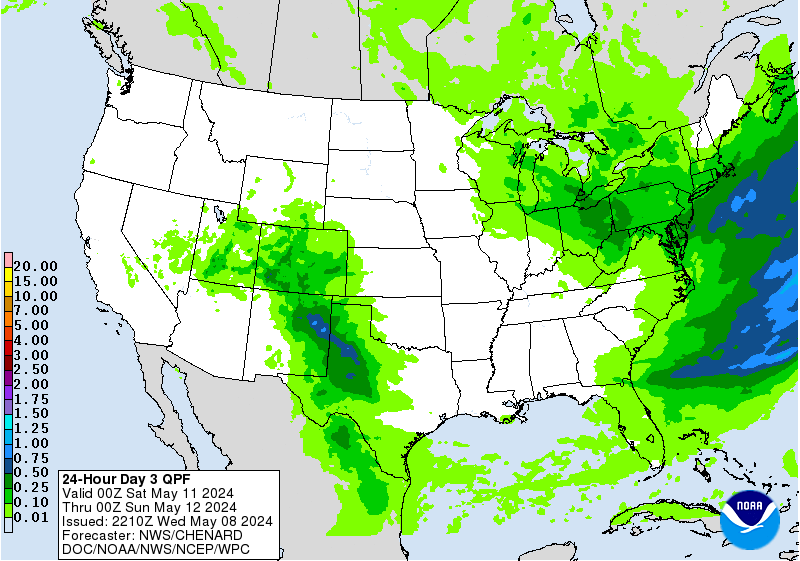
Days 4-5 below:
http://www.wpc.ncep.noaa.gov/qpf/95ep48iwbg_fill.gif?1526306162
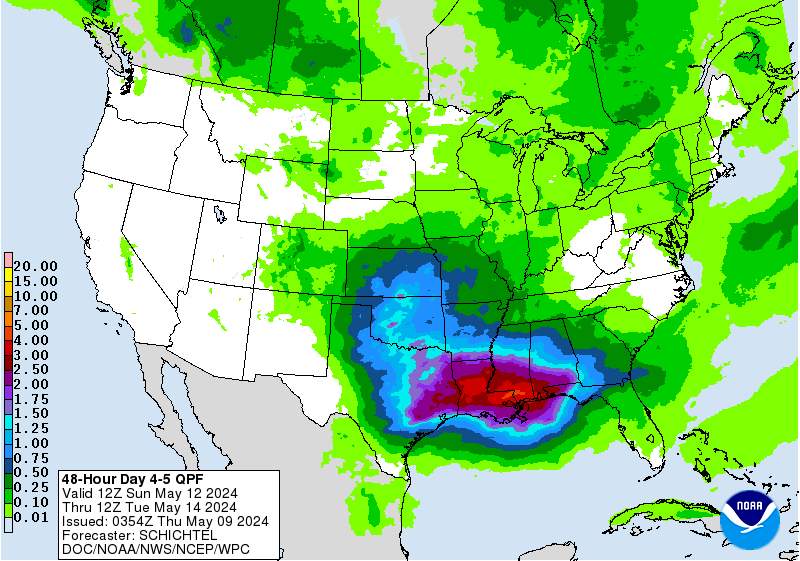
Days 6-7 below:
http://www.wpc.ncep.noaa.gov/qpf/97ep48iwbg_fill.gif?1526306162
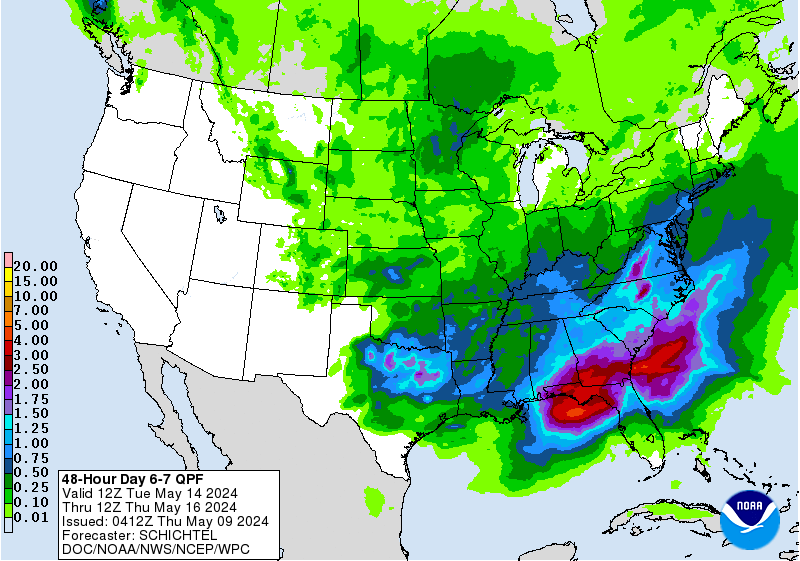
7 Day Total precipitation below:
http://www.wpc.ncep.noaa.govcdx /qpf/p168i.gif?1530796126
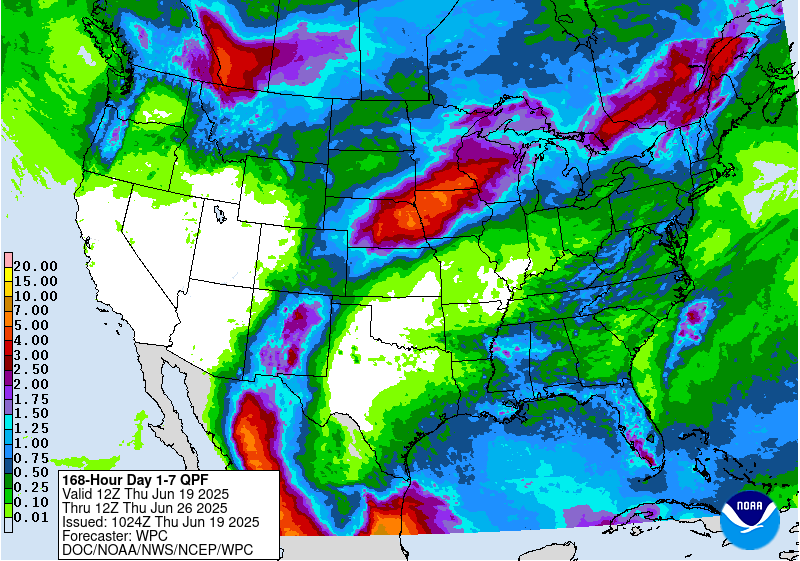
Current Dew Points
Widespread dry air in place...................green shaded moisture pretty far southeast.

Latest radar loop
http://www.nws.noaa.gov/radar_tab.php

| Full resolution version loop (3400x1700 pixels - 2.2mb) |

Go to: Most Recent Image
Precipitation the past 24 hours
![]()
You can go to this link to see precipitation totals from recent time periods:
https://water.weather.gov/precip/
Go to precipitation, then scroll down to pick a time frame. Hit states to get the borders to see locations better. Under products, you can hit "observed" or "Percent of normal"
+++++++++++++++++++++++++++++++++++++++++++++++
+++++++++++++++++++++++++++++++++++++
Precipitation compared to average for the last 7, 14, 30 and 60 days.
Usually not updated for previous day until late the next day.
https://www.atmos.illinois.edu/~snodgrss/Ag_Wx.html




The top map is the Canadian ensemble average, the maps below are the individual members that make up the average
+++++++++++++++++++++++++++++++++++++++++
Each member is like the parent, Canadian model operational model.......with a slight tweek/variation in parameters. Since we know the equations to represent the physics of the atmosphere in the models are not perfect, its useful to vary some of the equations that are uncertain(can make a difference) to see if it effects the outcome and how.
The average of all these variations(ensembles) often yields a better tool for forecasting. It's always more consistent. The individual operational model, like each individual ensemble member can vary greatly from run to run.........and represent an extreme end of the spectrum at times. The ensemble average of all the members, because it averages the extremes.............from opposite ends of the spectrum.........changes much less from run to run.
End of week 2....................0z ensembles from FRIDAY:
Analysis starting from a week ago, ending with today:
Last Wednesday: Battle between strong upper level ridge in the Southeast pumping up warm/moist air and northern stream coming out of Canada. The average/mean depicts something that is not on most models........will Northeast turn cold again?
Thursday: Huge question mark on how cold it will get late in week 2. Some solutions get very cold again(more today than yesterday at the end of week 2). How deep and where will the upper level trough be? How tenacious will the upper level ridge in the far Southeast be?
Friday: Giant sized disparity in solutions. Stronger upper level ridge Alaska/NW Canada and downstream trough couplet is more favorable for cold air delivery south..........on some solutions. Far Southeast upper level ridge hangs on with some solutions. Very favorable for active, stormy(some snow/ice) and heavy precip.
Saturday: Same general theme with less amplitude to the upper level ridges in the Southeast US and far W.Canada. In fact, the upper level trough has shifted farther east towards the Great Lakes on the mean. So more cold gets farther east/southeast in the US.
Sunday: Much milder at the end of week 2 today. The upper level ridge in the Southeast/East is stronger and the positively tilted trough to the west has more positive tilt and the trough line is farther west......imparting a more southern component to upper level winds in the southeast quadrant of the country.
Monday: Colder today, with the upper level and northern stream aimed a bit farther east.
Tuesday: Very similar to yesterday. Cold northern stream pretty dominant but a few solutions have the upper level ridge in the Southeast holding on.
Wednesday: Upper level trough a bit sharper and farther west, which works in tandem with an increase in downstream upper level ridging to the east and provides a milder outlook in the East. Northern stream still not dead.
Thursday: MUCH MUCH colder. Northern stream carves out a deep trough into the Great Lakes to Northeast...bringing another polar vortex excursion unusually far south. Upper level ridge in the Southeast is gone.
Friday: Still looks VERY cold with the full latitude, large scale ridge W.Canada and deep trough downstream couplet associated with a strong northern stream flow.
Saturday: Just prior to this period, during week 2, the Canadian ensembles is milder but at the end of week 2 is just as cold as recent solutions. This is becoming a pattern now..........models showing extreme cold near the end of week 2 every day but it never gets any closer. The extremely cold pattern at day 14, described above is still valid for today's analysis. It should be noted that some solutions on some models are trying to undercut this cold pattern with mild Pacific flow. On the maps below, for this model that is not the case, except for a small minority.
360h GZ 500 forecast valid on Mar 03, 2019 00 UTC
0Z GFS Ensembles at 2 weeks:
Analysis, starting with a week ago:
Last Friday: Different than the Canadian ensembles! More cold aimed towards the Northeast, not as much upper level ridging in the Southeast.
Saturday: More upper level ridging in the Southeast/East than yesterday. Anomalous upper level trough to the west. Heavy precip. Cold West/Central, warm East.
Sunday: MUCH stronger Southeast ridge from the Southern Stream than the Canadian model and pretty good agreement on most solutions........pumping in copious moisture an warmth, with an upper level trough in the West likely. Colder air in the northwest to northcentral sector will have a tough time penetrating deeply towards the southeast.
Monday: Pretty strong upper level ridge in the Southeast to possibly up the East Coast............so mild there and points just west(with tons of moisture pumped up for the Gulf). Trough much farther west with cold air feeding in.
Tuesday: Northern stream much stronger and farther southeast today.........with cold getting pushed farther into the Midwest/Northeast than yesterday. Colder than yesterday and colder than the Canadian model. A few VERY cold solutions.
Wednesday: Northern stream looks pretty potent(with cold) in NorthCentral to Northeast........??? Where will the upper level trough be??? How strong will the upper level ridge in the far Southeast be?
Thursday: The GFS ensembles, in contrast to the cold Canadian model is much warmer in week 2 and continues thru the end.........at least in the East, where the upper level ridge in the Southeast holds stronger.
Friday: Not as amplified at the Canadian model. More zonal, less cold able to penetrate as far south. Ridge in Northwest Canada not as significant.
Saturday: Huge disagreements in the East from run to run and with individual solutions. The overall picture suggests an upper level trough being carved out in the Northeast, which would promote cold but this is contingent to the southern stream, upper level ridge in the Southeast cooperating and departing.
Sunday: Very much in doubt at the end of week 2 with the biggest question on this model being how much northern stream energy will be able to carve out an upper level low in Southeast Canada and where will the position be? If it digs farther south into the Northeast US, then the East is cold.............which some solutions show. However, the majority do not. Then there's the upper level ridge in the Southeast from the southern stream. How strong will that feature be? There is the potential of some places in the East to be 40 degrees warmer or colder based on one extreme of the other to verify.
Monday: Colder today at 2 weeks. Upper level ridge in the Southeast is out of the picture. Colder air to the northwest is allowed to settle east with less resistance.
Tuesday: VERY impressive northern stream. Some have the polar vortex plunging unusually far south again, which would bring extreme cold.
Wednesday: Individual solutions not available but here's the mean(average). First one is upper levels, 2nd one 850 temps. Though it shows cold in the Midwest, it's not nearly as cold as yesterday. The extreme solutions with the polar vortex dropping south are going away.
Thursday: Much colder. Deep upper level trough into the Midwest/Northeast, possibly back to the Plains and even farther southwest..........depending on the upper level ridge in the far Southeast which is still evident on this model.
Friday: Similar to yesterday. Upper level ridge W.Canada and strong downstream trough carved deeply into the US. Will the upper level ridge in the Southeast hold on? Seems to be looking like no it won't but its been tenacious. If it stays there, everything is backed up farther west and it could stay mild in the Southeast.
Saturday: The big news here is the sudden introduction of a brand new pattern by some solutions, starting with the 0Z GFS lateFriday evening....seemingly out of nowhere. Instead of the highly amplified ridge W.Canada and deep trough downstream, we suddenly have a powerful Pacific jet stream cutting west to east, zonally across the country and cutting off the extreme cold dropping south(deflecting the northern stream into Canada). Should this pattern verify, temperatures in the NorthCentral US would be 30 degrees warmer than what they would be compared to the previous pattern. WOW! I am skeptical of these solutions for now but they might be picking up on something.

Latest, updated graph/forecast for AO and NAO here, including an explanation of how to interpret them.
Previous analysis, with the latest day at the bottom for late week 2 period.
Last Tuesday: AO rises to very positive in week 1, then later in week 2 may plunge again. NAO is positive but drifts lower in week 2. PNA is negative in week 1 but increases to around zero by the end of week 2. Potential to turn sharply colder on some models(GFS ensembles) near the end of week 2 but with much uncertainty.
Wednesday: The connection to this site was not working this morning but one can guess that late week 2 indices may be morphing cold with a wide spread.
Thursday: The AO, which increases a great deal in week to strongly positive, plunges in week 2, back into negative territory by the end of week 2. This increases the chance of very cold air shifting farther south during the 2nd half of February. The NAO which will be slightly positive, also drops down near zero at the end of the period. The PNA is negative for 2 weeks, which favors the cold making it into the west.
Friday: AO goes from positive in week 1(unfavorable for cold to drop from high to low latitudes) to slightly negative in week 2............more favorable, with a lot of uncertainty. NAO goes from positive in week 1 to around zero at the end of week 2 with a few negative and PNA from negative to almost zero. Not seeing today's indices as being decisive enough to provide a strong clue on late February weather.
Saturday: Pretty clear trend. AO goes strongly positive in week 1, then crashes lower. Ending up fairly negative at the end of week 2 and dropping. This increases major cold risks for the 2nd half of February(favorable for air masses to move from high latitudes to mid latitudes). The NAO is positive in week 1(less cold in the Northeast) to slightly negative late in week 2(increasing chance for cold in the Northeast/East). The PNA stays a bit negative for 2 weeks. Favoring cold in the West the entire period.
Sunday: AO has very wide spread, starting unusually early, late in week 1, when most are positive to strongly positive but a couple veer negative. Week 2 features an over all drop with individual solutions zig zagging telling us not to count on this indicator as being reliable for that period. NAO is positive but gradually falling in week 2, down to near 0 at the end, mostly from solutions that think there will be an upper level low in Southeast Canada. PNA is negative(favoring cold in the West vs the Southeast) but very slowly increases to close to zero at the end. On Friday, these indicators were more favorable for late Feb cold than they are today. However they are in a state of flux.
Monday: AO is positive but drops in week 2.........more favorable for cold then with great spread. NAO is close enough to zero with a slight negative tilt late. PNA is negative but increasing. Nothing to write home about...............or on a forum (-:
Tuesday: AO, which is positive in week 1 drops in week 2. On some solutions, the AO drops off a cliff into extreme negative territory. Those solutions have a situation similar to the extreme cold of January and polar vortex displaced very far south. NAO falls into negative territory by the end of week 2. PNA is negative but gradually trends upward to nudge a tad above zero at day 14. Indices are increasingly favorable for widespread cold from high latitudes to be transported to the mid latitudes and penetrate deeply in the US in week 2 and beyond.
Wednesday: AO, which is positive in week 1 drops but not nearly as far as yesterday's huge plunge...........today only to around zero without the extreme negative solutions from the polar vortex dropping south.............much less risk for extreme cold to be transported from high latitudes to mid latitudes(with gusto) later this month. NAO is around zero. PNA increases in week 2 to a tad above zero.
Thursday: AO, which is positive in week 1, drops in week 2 and is a bit negative at the end of the period but with a wide spread. NAO is close to zero, maybe a slight negative bias in week 2. PNA goes from a bit negative to a slightly positive. Looks modestly favorable for cold air to move south at the end of the month.
Friday: A tremendous amount of spread in the indices at the end of week 2. The AO and PNA are becoming more favorable for cold to penetrate in the US, the NAO is close to zero. Take these with a grain of salt. The actual models overnight looked colder at the end of week 2, however which has me leaning cold to very col to start off March.
Saturday: AO is solidly positive in week 1 still. Then drops in week 2 but only to around zero, with still plenty of spread. NAO has a wide spread with a slight positive bias at the end of 2 weeks. PNA has a slight negative bias. The week 2 and beyond forecast is now extremely chaotic because of the metamorphic solutions which introduce a zonal Pacific flow spreading across the country.........while other solutions maintain the previous, amplified flow(ridge W.Canada/trough downstream, very deeply into the US)
The link below, now has the PNA index added at the bottom:
National Weather Service 6-10 day, 8-14 day outlooks.
Updated this afternoon:
Morning synopsis from overnight weather models:
Big battle between the upper level ridge in the Southeast and southern stream and upper level trough to the west with northern stream cold air feeding into it...........these features will cause a lot of precip!
Monday and Tuesday featured the northern stream winning the battle and gradually pushing the colder air farther southeast.
Wednesday has reversed and the southern stream is stronger than it was the prior 2 days.........milder in the South and East during week 2.
Thursday has reversed again and the northern stream is MUCH stronger than its been all week. Looks good for the cold air to progress eastward...........looks like metmike and the models making that proclamation earlier were premature (-:
Friday: Looking colder
Saturday: Milder week 1. Week 2 is in complete disarray. Whatever comes out this afternoon is not likely to have great meaning.
Temperature Probability | |
Precipitation Probability | |
| the 8-14 day outlooks ArchivesAnalogsLines-Only FormatGIS Data | |
Temperature Probability | |
 | |
Re: Re: Re: Re: Weather Friday
By metmike - Feb. 15, 2019, 12:48 p.m.
The 12z operational GFS and ensembles were quite a bit colder in week 2, especially late in the period.
This lines up with my colder overnight forecast for that period.
The Canadian model still looks pretty cold also.
This has given the ng a little late morning bounce.
We have an incredible disparity in week 2 with extremely varying solutions from run to run, in especially the GFS operational model.
Last nights 0z GFS operational model suddenly brought in a mild zonal jet stream blowing out all the cold during week 2 that sort of came out of nowhere.
This mornings 12z run was back to a polar vortex type low dropping pretty far south and very cold in the northern tier especially. The latest 18z run just out is incredibly milder again.
The first set of maps below is from the colder 12z GFS. Big Arctic high pressure pushing frigid air south of the border. Polar vortex in the Upper Great Lakes:
gfs_namer_360_200_wnd_ht | gfs_namer_360_500_vort_ht |
gfs_namer_360_1000_500_thick | gfs_namer_360_850_temp_ht |
The 2nd set of maps below from the 18z GFS has no such thing. Completely different with mild Pacific air spreading into the Plains and temperatures 50 degrees warmer than the 12z run in that region.
gfs_namer_360_200_wnd_ht | gfs_namer_360_500_vort_ht |
gfs_namer_360_1000_500_thick | gfs_namer_360_850_temp_ht |
The GFS ensembles at 18z actually came out a bit colder than their 12z run and look pretty cold late in week 2, which do the Canadian ensembles.
However, some of the GFS ensemble solutions are showing the same milder solution, as noted below in the individual solutions from the 12z run.
Of the 12 solutions below, 6 have the milder, zonal flow and around 5 look very cold with some of those featuring an extreme southward placed polar vortex with record cold.

This is what the 18z ensemble average looked like for the GFS at 360 hours..........14 days.
That's pretty cold in the Midwest to Northeast. The ensemble mean is always the most consistent product and usually much more reliable. However, there are now 2 diverse camps on what will be happening at that time frame.
The frigid one that has been advertised for much of the last week, featuring a southward excursion of the polar vortex..........possibly into the Great Lakes with record old on the extreme versions.
And the new one that just popped up less than 24 hours ago on the GFS products. Mild, zonal Pacific flow blowing in from west to east and blowing out the cold.
So let me speculate. Possibly, there is great case to make for both these features and they will both affect the weather in early March..........battling each other for control of the weather pattern in the US.
It appears as if the long lived upper level ridge in the Southeast will be killed off as these new features take over.
So instead of very cold centered in the Plains/Rockies and very warm in the Southeast, like the recent one...........the milder Pacific air will warm up the Rockies, possibly into the Plains at times. The focus for the cold will shift eastward and the resistence to the cold, the upper level ridge in tbe Southeast, will vanish in the East, allowing more cold farther east also.
However, just a slight chance on model runs recently has resulted in a massive change in the position of the polar vortex low...........which will be affected by how the new Pacific jet stream interacts.
Regardless, there looks to be an enormous temperature gradient somewhere, between the bitter cold and milder Pacific air.
Forecast Hour: 360
Image URL: http://mag.ncep.noaa.gov/data/gefs-mean-sprd/18/gefs-mean-sprd_namer_360_500_vort_ht.gif

Forecast Hour: 360
Image URL: http://mag.ncep.noaa.gov/data/gefs-mean-sprd/18/gefs-mean-sprd_namer_360_850_temp.gif
